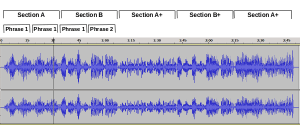 In the third part of this series we looked at the Orchesta Tipica, the instruments and how they express different elements of the music. Now we can look at the structure of a tango tune in more detail.
In the third part of this series we looked at the Orchesta Tipica, the instruments and how they express different elements of the music. Now we can look at the structure of a tango tune in more detail.
I will look at one popular tune ‘Mimosa’ recorded by the Francisco Canaro Orchestra in 1929, hence the lovely picture above… but maybe the tune was named after the orange and champagne drink? 🙂 I will show how the structure breaks down into musical phrases, sections, and other components, and how these components often repeat (with variation). This means that even if a dancer is not familiar with a tune, they can predict (guess?) what the music is likely to sound like once they’ve heard the first couple of sections, and so better interpret the second half of a tune with their dancing.
OK so we are going to listen to ‘Mimosa’, and the different sections of that tune, so we can compare the different parts, but first I’d like to show you a pictorial representation of the tune so you can more easily visualise the elements of a tune. The first thing to notice is that this tune has 5 sections of approx 34 seconds each, resulting in an overall tune length of 2:50 minutes.
The first thing to notice is that this tune has 5 sections of approx 34 seconds each, resulting in an overall tune length of 2:50 minutes.
I’ve labelled each section and you’ll notice that there are only really 2 sections of differing melody, A and B, but in the sections labelled A+ and B+ there are some variations. The middle section A+looks different from the other Section A’s but that’s really only because the overall volume of that section is reduced. The waveform shapes are still similar.
The overall melody within two similar sections stays the same, but often different instruments play the melody in different sections. Sometimes (but not in Mimosa) there is a key change when a section is repeated. These variation to make it less boring to listen to.
Here is the entire tune to listen to first. See if you can pick out the repetition.
Now what follows are the different sections to listen to.
‘Mimosa’ Section A
You’ll notice in the diagram, Section A has one phrase repeated. Each phrase also contains a repeated refrain. Also listen out for the ‘pom pom’ at the end of the section. It tells a dancer that the section has finished and a different melody is about to start.
‘Mimosa’ Section B
In Section B we have two different phrases with each phrase containing a different repeated refrain and the whole Section B being a different melody to Section A. Also we have the ‘pom pom’ at the end of the section.
‘Mimosa’ Section A variation 1
In Section A var 1, it sounds like you have a new melody (the guitar) and this is true, but if you listen to the background the guitar is over-layed onto the melody from Section A, so you still have that ‘anchor’ to something you’ve already heard. Again we have the ‘pom pom’ at the end.
‘Mimosa’ Section B variation 1
In Section B variant 1 the ‘Phrase 1’ of the variation has the Bandoneon playing a slightly different refrain from the original Section B, but ‘Phrase 2’ is pretty much identical as played in the first Section B. Again we have the ‘pom pom’ at the end.
‘Mimosa’ Section A variation 2
In the final section variant 2 of Section A, we now have a new melody played by violins, but again listening to the background, the refrain is Section A again. Finally we have a more dramatic ‘pom pom’ at the end of the tune.
Listen again to the full tune with all the sections in the correct order and imagine how you might interpret this tune in your dance expression.
Is this the standard for writing tango tunes?
If you’ve ever wondered why so many tango tunes seem to be between 2:30 to 3:00 minutes long, the reason is that composers would create a walking beat of approximately 64 per minute (or 32 bars of music per min in 4/4 time). This would be 2 of the sections shown.
If a composer sticks to the ‘5 section’ tango format then the length of a tango will be about 2:30 min. This would be 80 bars of music and a total of 320 music beats.
For a fast tango at a tempo of 160 musical beats per minute, the 80 bars of music are finished in 2 mins. For a slow tango at a tempo of 110 musical beats per minute the 80 bars of music lasts 2:54 mins. It’s basically just maths 🙂
So, it look like we have a standard tango tune format?
Well yes and no. Many composers and orchestra arrangers did indeed stick to the ‘5 section’ tango format over many years, but we are discussing music, an art form, so there are other variations to this ‘standard’. Indeed Francisco Canaro later in his career introduced the prelude, interlude, and longer endings into his music. However hidden inside all the ‘extras’ you will find enough repetition of sections and phrases to make it easier for you to interpret tunes for your dancing.
In the next section of this series I will begin to examine different popular orchestras so we can understand that different tunes perhaps need different dance interpretation.




